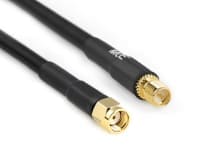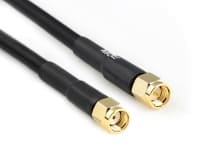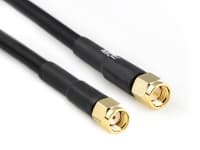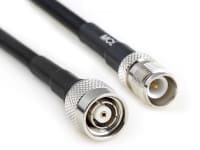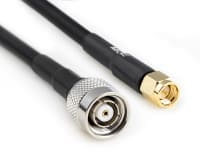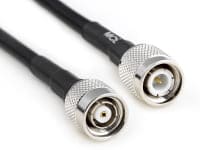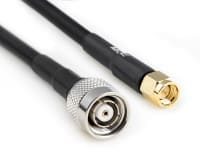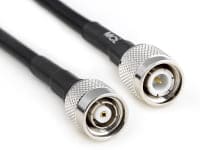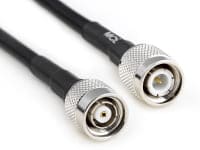WLAN Antenna Cable Assembly
WLAN Antenna Cables
Connector types: RP SMA Male Connector, RP TNC Male Connector, RP N Connector
Coaxial Cable types: Aircell 5, CLF 200, CLF 240, H 155, H 155 PE, H 155 LSNH
We generally assemble coaxial cables according to customer requirements. The cables listed here therefore represent only a small selection.
If you can not find the desired WLAN antenna cable here, please contact us. By phone, by email or via our contact form.
More categories
Coaxial cable for WLAN
WLAN stands for Wireless Local Area Network, ie wireless local area network. External antennas are connected via coaxial cable to the access point (AP), which enables a fast and flawless data transport with a variety of devices or stations, which of course have to be radio-enabled, within a local network.
The router is the link between the Internet and the WLAN. The WLAN is therefore a pure subnet in which you can then wirelessly / wirelessly move with your devices. Of course, this wireless freedom of movement within the subnet only works within range as the signal strength of your local wireless network allows.
Please note the max. permissible radiation powers which have been set by the Federal Network Agency for the individual frequency bands.
WLAN and LAN - The subnet
Sure, the local network can also be completely wired. Of course, internal data security is greatest. The weak point is the possible cable lengths and in addition, you can not move freely. All devices are stationary in a fixed location to operate. Some devices do not necessarily have a built-in WLAN option. For example, a printer does not have to be mobile all the time. Once firmly installed and connected to the switch, HUB or router via cable, it can also be used by anyone who has access rights via a notebook or PC.
With notebooks, mobile phones and VoIP phone you would certainly be flexible. Since WLAN is useful again. With a suitable antenna connected to the access point with coaxial cable and reaching a certain, defined area, this is a nice thing today.
Both can be in the subnet, so the LAN, merge great, then come on the router into the Internet.
WLAN frequency bands (DE)
The Federal Network Agency, also known as RegTP (Regulatory Authority for Post and Telecommunications) has defined the following frequency ranges and antenna radiated power for general public WLAN:
Frequency range 2,400 GHz to 2,4835 GHz, max. Radiation power 100 mW EIRP. That corresponds to 20 dBm.
Frequency range 5,150 GHz to 5,350 GHz, max. Radiation power 200 mW EIRP. That corresponds to 23 dBm.
Frequency range 5,470 GHz to 5,725 GHz, max. Radiation power 1.0 W EIRP. That's equivalent to 30 dBm.
There are other WLAN frequency ranges above 60 GHz, which are not discussed here.
EIRP and ERP - What is it?
The radiated power of antennas is increasingly indicated in EIRP. EIRP stands for Effective Isotropic Radiated Power. The only antenna form with an isotropic radiant power is an antenna in the form of a sphere, ie an antenna shape that does not exist in practice. Only a spherical antenna could radiate its effective power evenly and non-directionally in all directions, that is spherical.
The radiation power of antennas in the field is always measured in practice with a dipole, ie a directional, two-pole antenna and that in ERP. ERP stands for Effective Radiated Power. Certainly, when developing a new antenna, it can and will be measured all the way around until all the points that resemble a sphere are used to detect the characteristic of the antenna radiation in free space. However, there are guidelines and specifications for the correct recording of these measuring points, which must be strictly adhered to.
dBi and dBd - the antenna gain
We are also indebted to the steady pursuit of supposedly higher profit data from antennas for the deduction of the dBi as a profit statement. Again, the ball was used as a unit of measurement again.
As previously described in ERP and EIRP, antenna gains that are always higher in dBi than the long-term known gain indication with the simple dBd unit. For decades, the gain of an antenna is and was measured via a half-wave dipole.
For many antennas that come from Japan, one might suspect that the even more praised antenna gain could only be dBj. Infected by high antenna gains were initially more Asian countries. The data in dBi come from there. This dB virus was introduced to Europe around 1990.
Physics can not be changed by specifying dBi. If you subtract 2.15 dB from the gain specified in dBi, then you're back to values that allow you to sensibly and correctly select and calculate your coaxial cable for attenuation.
WLAN, antenna and coaxial cable
Maybe this little enlightenment of individual terms and units of measurement will also make you smile about the cabling of wireless networks, which are not wireless at all. You simply can not get wired by using Wi-Fi using antennas and coaxial cables. It is already a big step forward, not necessarily having to take a firm place with his notebook in order to keep in touch via the Internet and to gain new ones.
WLAN coaxial cable and connectors
For the cabling of the WLAN antennas with the access point we recommend modern, double shielded coaxial cables with low cable attenuation and a good shield against unwanted radiation. With very short cable lengths, cable types with only 3mm outer diameter can be used. Mostly, however, cable types such as Aircell 5, H 155 and the CLF 240 are used. With increasing cable length, the cable attenuation increases at the same frequency. To counteract this physical property, coaxial cables such as Aircell 7 or also H 2007 with a diameter of 7.3 mm are used. If the cable loss should still be too big then, of course, you can also use Aircom Premium, Ecoflex 10, H 2010 from Belden or even Ecoflex 15.
Connectors for WLAN come almost exclusively from the series BNC, TNC, SMA, N and MMCX and bear for precise marking today at least one "R" in front of the plug designation, in the beginning even a "RP" for reverse polarity. Also, other new connectors for the WLAN connection have been designed, which are nowhere else find application.
So when selecting the plug on the prefix "R" or "RP" pay attention, so you do not experience a nasty surprise.
RP BNC, R BNC, RP TNC, R TNC, RP N, R N, RP MMCX, R MMCX are common names for connectors specifically for WLAN. There are also designer connectors with corresponding designations of the individual manufacturers of antennas, routers, access points and USB sticks.
If you are unsure then better ask before buying. We are happy to help you with our knowledge from many years of practical experience.

